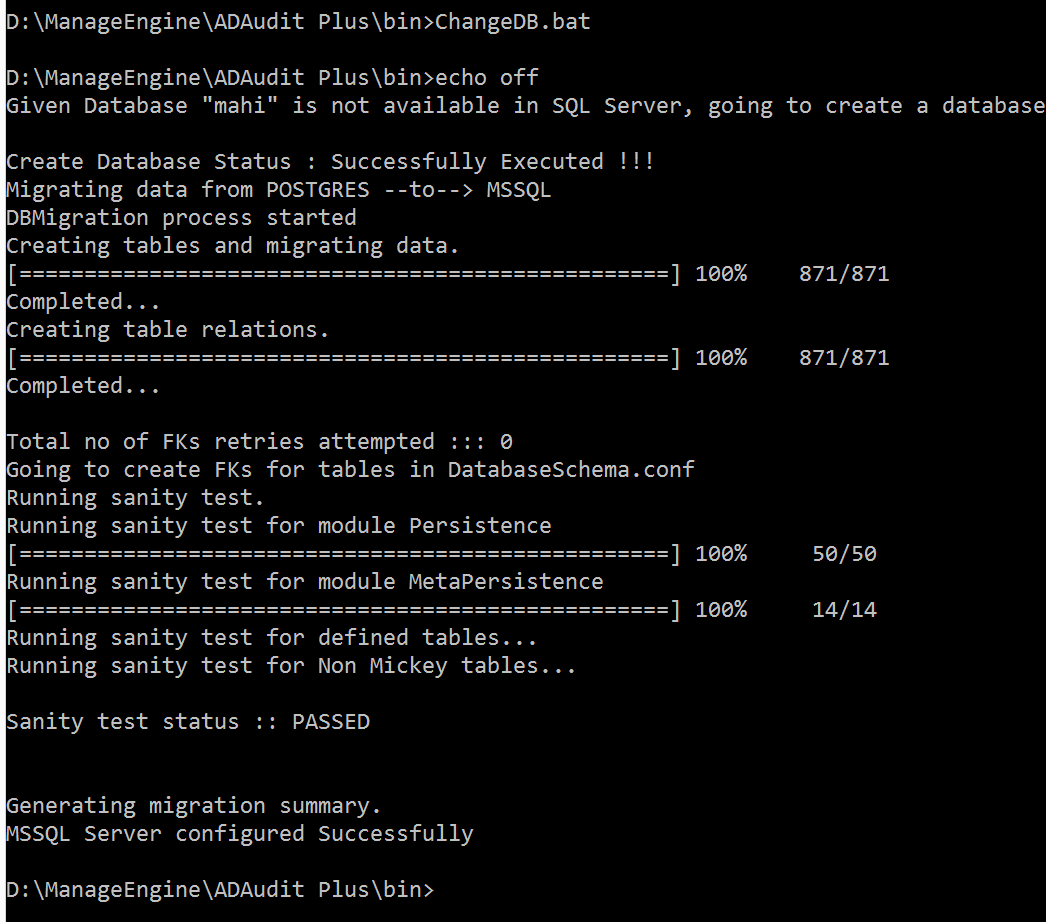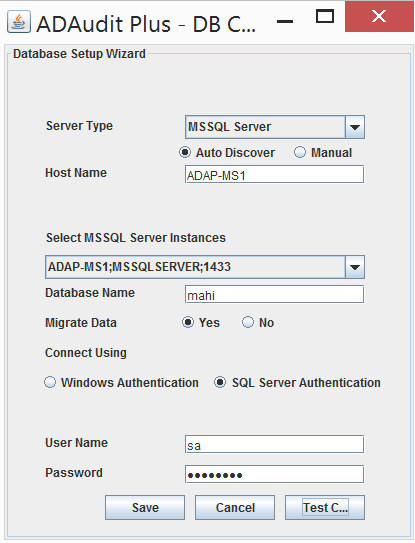PostgreSQL/MySQL to MS SQL Migration
ADAudit Plus allows administrators to store and retrieve Windows servers' audit log data from MySQL, MS SQL, or PostgreSQL databases.
By default, ADAudit Plus comes bundled with PostgreSQL database. To move the DB and/or data from PostgreSQL/MySQL to MS SQL, set-up the prerequisites first and then initiate movement.
The following versions of MSSQL are supported:
- SQL server 2008 R2 (EOLed by Microsoft)
- SQL server 2012
- SQL server 2014
- SQL server 2016
- SQL server 2017
- SQL server 2019
1. Configuring the MS SQL server
- Open the SQL Server Configuration Manager on the computer running the MS SQL instance (to which the DB and/or data is to be moved).
- In the left pane, click SQL Server Services --> Ensure that the SQL Server Browser is running.
- In the left pane, click SQL Server Network Configuration --> Select Protocols for (the given instance) --> Enable TCP/IP.
Note: The given instance refers to the MS SQL instance to which the DB and/or data is to be moved. - In the left pane, click SQL Native Client Configuration --> Select Client Protocols for (the given instance) --> Enable TCP/IP.
- Restart the SQL Server Service.
2. Providing permissions to the MS SQL instance
The user account associated with ADAudit Plus must have access and appropriate permissions to the MS SQL instance (to which the DB and/or data is to be moved).
Note: If SQL Server Autentication is used to move the DB and/or data, access and permissions to the MS SQL instace are automatically provided. However, when Windows Authentication is used, access and permissions have to be granted, as explained below-
(i). To grant access- Login to Microsoft SQL Server Management Studio with an account that has been assigned the sysadmin role → Select the server instance to which you will be migrating → Security → Logins. Check whether the user running ADAudit Plus is on the list-
- If the user is already listed → Proceed to 2(ii).
- If the user is not listed, right click on Logins → New Login → Create a new login → Proceed to 2(ii).
(ii). To grant permissions- Right click on the user → Properties → Server Roles → Check whether the user has been assigned the sysadmin role-
- If the user has → Proceed to 3.
If the user has not → Select sysadmin in the checkbox and click OK → Proceed to 3.
Note: To grant the user only the minimum permission required instead of sysadmin role, follow the two steps found below:
- Right-click on the user → Properties → User Mapping → Select db_datareader, db_datawriter, db_ddladmin in the checkbox and click OK.
- Right-click on the database → Properties → Permissions → Provide 'Execute' permission for the user and click OK.
- Also, execute the below query in the database: Right-click on the database → New Query → GRANT CONTROL ON CERTIFICATE::[ZOHO_CERT] TO [newly_created_user]
3. Enabling communication with the MS SQL server
If ADAudit Plus and the MS SQL instance are running on different computers-
Download and install SQL native client, command line utilities, and ODBC Driver; in the computer on which ADAudit Plus is running.
SQL Server version Command Line Utilities (cmdlnutils) Native Client (ncli) ODBC Driver (odbc) 2008 https://www.microsoft.com/en-in/download/details.aspx?id=44272 https://www.microsoft.com/en-in/download/details.aspx?id=44272 Not needed. 2012 https://www.microsoft.com/en-in/download/details.aspx?id=36433 https://www.microsoft.com/en-us/download/details.aspx?id=50402 Not needed. 2014 https://www.microsoft.com/en-US/download/details.aspx?id=53164 Not needed. https://www.microsoft.com/en-in/download/details.aspx?id=36434 2016, 2017, and 2019 https://www.microsoft.com/en-us/download/details.aspx?id=56833 Not needed. https://www.microsoft.com/en-us/download/details.aspx?id=56833
Note: Native client, command line utilities, and ODBC driver version has to be the same as the MS SQL version (to which the DB and/or data is to be moved).
Copy the following 2 files from the MS SQL server installation folder to the ADAudit Plus bin folder-
- bcp.exe- <MSSQL Installation Dir>\Tools\Binn\bcp.exe &
- bcp.rll- <MSSQL Installation Dir>\Tools\Binn\Resources\1033\bcp.rll
Note:If ADAudit Plus and the MS SQL instance are running on the same computer-
Copy the following 2 files from the MS SQL server installation folder to the ADAudit Plus bin folder-- bcp.exe- <MSSQL Installation Dir>\Tools\Binn\bcp.exe &
- bcp.rll- <MSSQL Installation Dir>\Tools\Binn\Resources\1033\bcp.rll
4. Opening UDP and TCP ports (applicable only if the firewall is enabled in the MS SQL Server computer)
- UDP port number is 1434.
- To find the TCP port number, open SQL Server Configuration Manager on the computer where the MS SQL instance to which the DB and/or data is to be moved, resides. --> SQL Server Network Configuration --> Protocols for
. Right click on TCP/IP --> Properties --> IP Addresses --> IPALL --> TCP Port Number. - Open the UDP and TCP ports under firewall settings.
5.Move DB and/or data
- Stop ADAudit Plus.
Invoke (ADAudit Plus Home)\bin\ChangeDB.bat in command prompt. Make sure that the user running the command prompt is same as the one running ADAudit Plus.
-
- DB Configuration wizard will pop-up --> Select server type as MS SQL --> Select the Host Name, Instance Name, and Database Name.
- If you want to migrate existing data from the PostgreSQL/MySQL to MS SQL, then select Yes for the Migrate Data option. Otherwise, select No (for a new installation of ADAudit Plus).
If your MS SQL server is SSL enabled, then select Yes for SSL Encrypted. Otherwise, select No.
Note: The name of the MS SQL Server Instance has to be entered manually in case you have not chosen the Auto Discover option.
Tip: To learn how to create an SSL certificate in MS SQL server, follow step 1 found in this link.
- Select the Authentication type. If you have selected Windows Authentication, the credentials are automatically taken. If you have selected SQL Server Authentication, enter the corresponding credentials.
Note: If SQL Server Autentication is used to move the DB and/or data, access and permissions to the MS SQL instace are automatically provided. However, when Windows Authentication is used, access and permissions have to be granted, as explained in point 2 under pre-requisites. - Click Test Connection to check whether the credentials are correct.
- Click Save.
The migration procedure will start and it will take a few minutes to complete. Successful migration will end with the below screen-
Note: The data in archived files is stored in different formats across PostgreSQL and MS SQL. So, once the migration from PostgreSQL to MS SQL is comexplete, open the command prompt as an administrator → Navigate to <installation dir>\ManageEngine\ADAudit Plus\bin → Execute 'ChangeArchive2BCPSupport "C:\ManageEngine\ADAudit Plus\archive\tablebackup" "C:\ManageEngine\ADAudit Plus\archive\tablebackup_new" postgres mssql'.

